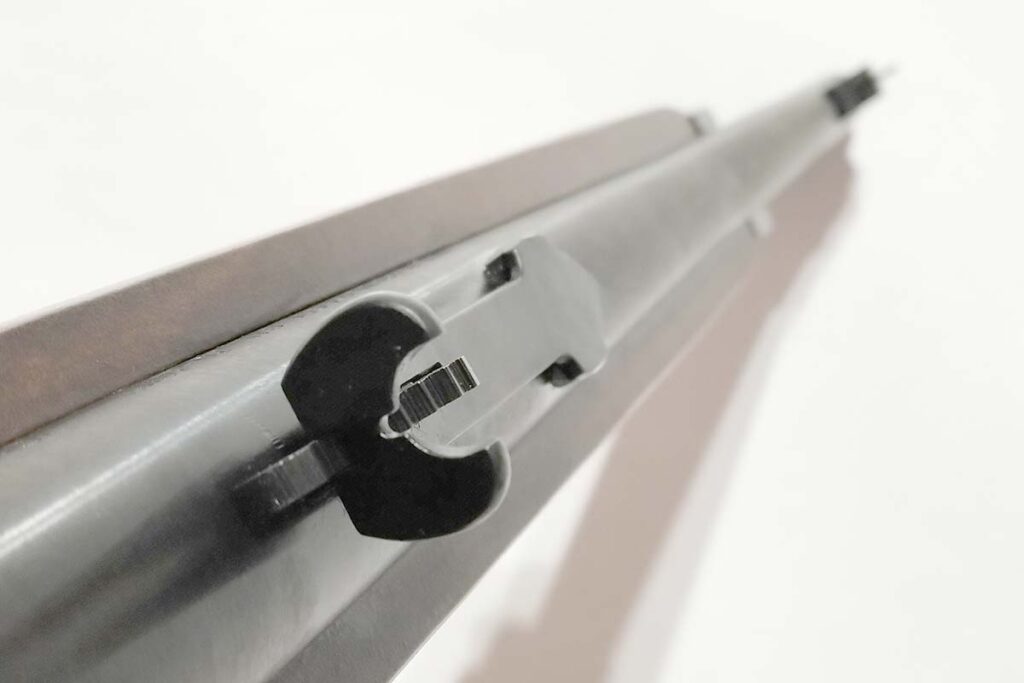
Right-sized in price and profile, the Rossi R95 Trapper is ready for hard duty in the field.
Likely, you’d have to return to the days when muscle cars were the epitome of cool to find a time when lever-action rifles garnered as much attention as they do today. Is it necessity, nostalgia or some other unseen force driving the resurgence? Honestly, it doesn’t matter.
What does is the renaissance of this style of long gun has resulted in the expansion and evolution of perhaps one of the handiest—not to mention enjoyable—rifles. This even goes for the more budget-friendly end of the market of these generally spendy guns. Case in point, the Rossi R95.
Released just in time for deer season late this summer, the Brazilian-made gun does the impossible for rifle-caliber lever guns—gives a sub-$1,000 option to the masses. A relief to many, given the somewhat archaic technology generally sends spasms into the most tender region of man’s lower extremities—his wallet.
Even more heartening, with an MSRP of $950, the rifle punches well above its price tag especially where it counts—downrange performance. At least, this was my experience with the R95 16.5-inch barreled Trapper model in a few trips to the range to put it through its paces.
R95 Familiar Origins
You’ll be forgiven if the R95 inspires a bout of deja vu. There’s plenty familiar with the 5+1 capacity .30-30 WCF if you even have a passing knowledge of Rossi or Marlin for that matter. For all intents and purposes, the new rifle is a revamped Rio Grande, which was a clone of the timeless Marlin 336. However, Rossi didn’t simply slap a new model name on its old clone and call it a day. Overall, the R95 is much more streamlined than the company’s previous attempt at a 336 and includes a few notable—and desirable—tweaks.

To the former point, and thankfully, Rossi utilizes a much better grade of wood in the R95—walnut—as compared to birch on the old rendition. Furthermore, the company textures the fore and grip to theoretically provide a better purchase on the gun, whereas the Rio Grande’s lumber was smooth as a newborn’s bottom. I intentionally throw in the word theoretically because I’m not completely sold on how the stock is textured. Pebbled, the pattern is very comfortable off the bench and in controlled environments but isn’t quite as aggressive as I’d want in a field gun. Especially anything likely to encounter inclement weather.
Nicely, Rossi has nixed the barrel bands on the R95. Some purest might grit their teeth at this move and I get the sentiment—it’s a clone, so why not stick with the pattern the gun is based on? Except, this move goes a long way in improving the overall aesthetics of the rifle, cleaning up its lines and giving the gun its own legs to stand on. Undoubtedly a small change, but one that caught my eye right out of the box and kept it fixed the entire time I tested it.

Intriguing as those changes are, the real meat of the R95 redesign—one might even venture to say upgrades—happen under the hood. In the bolt to be exact. The R95 uses a single-piece firing pin and a firing-pin block—similar to many striker-fired pistols—as its passive safety. Not that there were many complaints with the 336’s tilting-rear two-piece firing pin, but in theory, the Rossi system should offer a much more robust striking system.
Furthermore, the R95 boasts an AR-15 style extractor, compared to the stamped steel style of the Marlin. Both are equally stout ways to go about pulling brass, but I’d argue the Rossi system will win favor come disassembly. The stamped-steel extractor was never fun to pry off a bolt.
Other Notables
Adding better out-of-the-box effectiveness, Rossi opted for an elevation-adjustable buckhorn rear sight and driftable front sight on the new rifle. The inclusion of classic lever-action style sights should prove popular, given it improves the utility of the rifle offering both close- and mid-range aiming solutions. However, I would have appreciated factory-included indexing under the notch to better use the buckhorns. But at the price of the gun, it’s not a deal breaker.
Though, Rossi might have known what it was doing with more mid-tier sights. Given the R95 is a side ejector, it plays nice with optics, and like the gun it’s based off it will likely end up with an LPVO or 3×9 on its top side. Anticipating this, Rossi has drilled and tapped the receiver for the addition of your preferred optic.

A few other of the R95 Trapper’s notables include a rich, black oxide finish that sets off the dark bands in the walnut. The large loop looks right in place on the Trapper model and is proportioned modestly enough to get the rifle running. The spring tension on the loading gate is perfect, allowing for fast topping off of the gun’s tubular magazine. And the trigger, well… aside from the blade being made from stamped steel, it tripped at a very consistent 3 pounds. Also, Rossi didn’t skimp with the recoil pad, which proved more than ample and very comfortable.
At The Range With The R95
As things go, I walked away fairly impressed with the R95 Trapper’s performance. Running 200 rounds through the Trapper—140-grain Hornady LeverEvolution and 150-grain Federal Power-Shok—on two range trips, the carbine proved accurate and extremely reliable.
I didn’t opt to mount an optic on the gun, wanting to give the buckhorn sights a run, given I feel there is a substantial segment of this market who will opt to stick with the factory sights. At 100 yards, shooting off a bench and sandbags, the notch proved plenty accurate as did the rifle, printing right around 1 MOA. The gun seemed to prefer Hornady, with the groups showing more consistency with LeverEvolution in the chamber.

Switching to the buckhorns at 50 yards, the rifle was equally as intuitive and on target. Obviously, this method wasn’t as dead-nuts as using the notch and I used it from several shooting positions—offhand, kneeling, braced against a post. That's OK—the system isn’t meant to produce cloverleaves. Instead, buckhorns facilitate fast target acquisition and transition and allow the shooter to let the reigns out on the gun.
I did and it responded. The action is as fast as your lever hand can make it and it runs smooth—butter-smooth, an attribute that makes it intuitive to keep the rifle on target for follow-up shots. This short configuration has the makings to conquer hog hunters’ hearts.
As I said earlier, it’d be nice to have an indexing mark on the buckhorn—this addition would greatly improve response time. But it’s still passible as is and shouldn’t dissuade anyone from the rifle. As for reliability, I didn’t encounter a single hang-up in my time with the gun, something I’ve read was an issue on some Rio Bravos. Incidentally, the R95 spit brass like no tomorrow and at an angle that spent cases should never end up molesting an optic.
Dressing It Up
A final note about the R95—though it wasn’t part of the test—there is ample opportunity to play dress up with the gun. Midwest Industries, Marlin Point Precision and several other accessory companies have furniture that can give the gun a much more tactical bent. Generally speaking, going this route is much less expensive than buying a geeked-out tactical lever-action off the rack. Not to mention, you can tailor it exactly to your wants and needs. So, if you can’t live without an apocalypse-ready lever-action rifle, the R95 is only a few upgrades away.
Parting Shot
While the R95 might not be anything new for Rossi, the gun steps the company’s game up in the class of rifles. Perhaps not as nostalgic as a Winchester lever-gun clone, the Brazilian 336 mimic is entirely more practical for a modern shooter. At the very least, you needn’t wrestle with a bizarre scope mount to add an optic.

Rossi not only offers the Trapper model, but also a 20-inch barreled rifle—which might just be the ticket for folks who encounter a bit longer shot in their hunting season. But I can’t help being enamored with the Trapper. For me, it has all the features to make it a superb little brush gun, whether you’re still hunting deer in dark timber or hogs along the back forty’s thickets. It’s right-sized in every way for these duties, especially price.
Raise Your Lever-Gun IQ:
- The Henry .45-70 Gov't
- Evolution Of The Legendary Lever-Action
- Cowboy 101: How To Run A Lever-Action Rifle
- The Rossi Rio Bravo .22 Lever-Gun
- The Past, Present And Future Of Lever-Action Shotguns

Next Step: Get your FREE Printable Target Pack
Enhance your shooting precision with our 62 MOA Targets, perfect for rifles and handguns. Crafted in collaboration with Storm Tactical for accuracy and versatility.
Subscribe to the Gun Digest email newsletter and get your downloadable target pack sent straight to your inbox. Stay updated with the latest firearms info in the industry.

![Best Concealed Carry Guns In 2025 [Field Tested] Wilson Combat EDC X9S 1](https://gundigest.com/wp-content/uploads/Wilson-Combat-EDC-X9S-1-324x160.jpg)


![Best 9mm Carbine: Affordable PCCs [Tested] Ruger Carbine Shooting](https://gundigest.com/wp-content/uploads/Ruger-Carbine-Shooting-100x70.jpg)
![Best AR-15: Top Options Available Today [Field Tested] Harrington and Richardson PSA XM177E2 feature](https://gundigest.com/wp-content/uploads/Harrington-and-Richardson-PSA-XM177E2-feature-100x70.jpg)

Officer Graham here. Just purchased my Rossi R95 Trapper in 30-30 Cal.
I’ve wanted one of these for several years. The new updates and better quality
control made my decision easy. For the price of $620 it was a no brainer purchase.
A new Ruger/ Marlin cost twice as much.
9/24
Maybe it can only handle 30-30 pressures and not much more?
So sad & too bad Rossi chambered this new lever edition in the anemic, obsolete & unremarkable 30-30. There are so many new & better choices, like: 204 Ruger, 450 BushMaster, 458 SoCom, 350 Legend, 360 BuckHammer, 50 Beowolf, 400 Legend, 444 Marlin, 500 S&W Magnum, 460 S&W Magnum….
Some firearms manufacturers pay attention to the market, some need to pay more attention….
“New and Better”
That’s a very subjective, and perhaps inexperienced perspective …
Yes Sir !!….SO Right you are,….why the world is what it is….
….lol….sounds like your IQ & mentality is anemic….lol
HatMan,
Anemic? Obsolete? Unremarkable? Those are words I’d use to describe your comment.
The 30-30 has enough power for almost any North American game animal and yet the recoil is light. It has more options for ammo than all the calibers you mentioned–and it is WAY cheaper. How many of those calibers are available in a lever gun? Those are only a couple of the many reasons 30-30 has been around for over 100 years.
Go ahead. Buy a rifle chambered in a 458 SoCom or 460 S&W Mag and watch it gather dust because you can’t afford to shoot it. Even if you can, it isn’t enjoyable. I’d rather be entertained with a day of shooting a rifle that I know, when the time comes, can reliably place a shot to put meat on my family’s table.